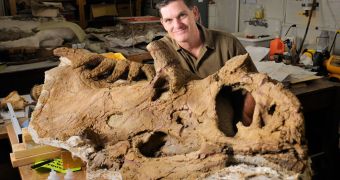A team of investigators managed to uncover two new species of dinosaur at a site in Utah. The creatures were slightly smaller than their most famous “peers,” but they make up for that by having over-sized, multi-horned heads.
Researchers basically describe them as a “giant rhinos with a ridiculously super-sized heads.” Details of how the creatures must have looked like when they were still alive were recently published in a respected journal.
“Fifteen long, pointed sideways oriented eye horns: one over the nose, one atop each eye, one at the tip of each cheek bone, and ten across the rear margin of the bony frill,” experts write of the animals.
One could not say that these dinosaurs were good-looking. In fact, scientists say that they most likely had the type of face that only a mother could be blind to.
The new species were dubbed Utahceratops gettyi and Kosmoceratops richardsoni, and were described in the September 22 issue of the esteemed open-access journal PLoS ONE, which is published by the Public Library of Science.
Paleontologists discovered the horned dinosaurs at the Grand Staircase-Escalante National Monument in southern Utah, which is a site that has revealed numerous fossils over the years.
Analysis of their shape, size, teeth and skull appears to indicate that the animals were close relatives of the more famous Triceratops, a dinosaur that sported three horns on its head.
The animals lived for millions of years in Laramidia, an ancient marshland of epic proportions, that existed somewhere in the middle of modern North America. At the time, the continents did not look very much like their more modern selves.
These dinosaurs lived during the Cretaceous Period, which ended with the K-T extinction event, more than 65 million years ago. All dinosaur species were killed in a few years.
“My enthusiasm for these findings is threefold,” explains the program director of the Sedimentary Geology and Paleobiology Program at the US National Science Foundation (NSF), Raymond Bernor.
“First, researchers discovered two new, exciting dinosaur species. Second, the research has accomplished a major advance in understanding the biogenographic provinciality of Western North American dinosaur communities that apparently included separate northern and southern populations,” he goes on to say.
“And third, this discovery has inspired future discoveries in the Grand Staircase-Escalante National Monument, which has now emerged as one of the most important paleontological reserves in the world,” he concludes.

 14 DAY TRIAL //
14 DAY TRIAL //